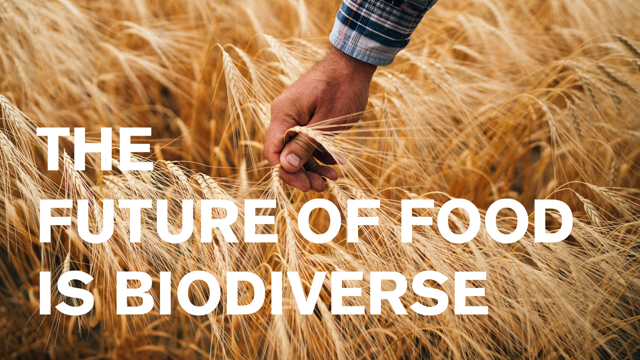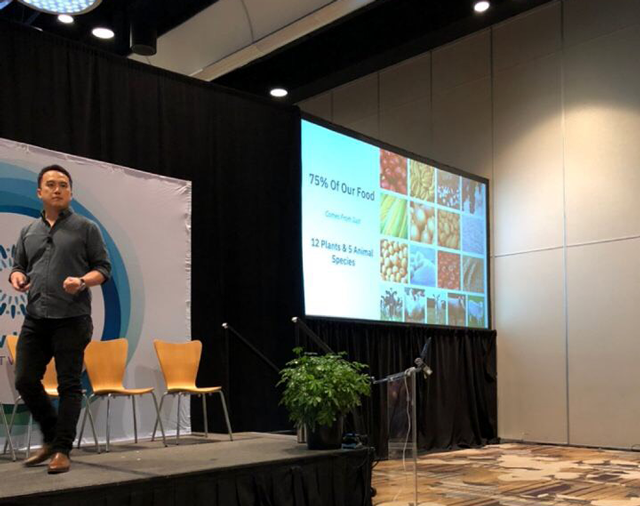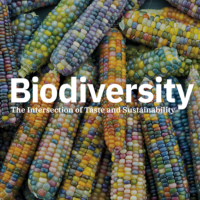
As over 90,000 food industry professionals packed the halls of the Anaheim Convention Center last week looking for the next big thing in CPG, three leaders from General Mills, Applegate and Kuli Kuli came together on stage to discuss one of the biggest emerging themes shaping the future of our food: biodiversity.
Promoting biodiversity — defined as the variety and variability of plants, animals, and micro-organisms in a system — is a key priority for each of these companies, and it’s a key element within the broader regenerative agriculture movement.
In the panel, moderated by Danielle Gould, founder of Food+Tech Connect, and hosted by General Mills, Food+Tech Connect and The Future Market, the group dove deeper into what it means to support biodiversity, the benefits it has to people and planet, and the opportunities to help consumers recognize and support the value of a more biodiverse, regenerative agricultural system.

The Panelists (l to r): Danielle Gould, Food+Tech Connect; Gina Asoudegan, Applegate; Shauna Sadowski, General Mills; Lisa Curtis, Kuli Kuli.
Why Biodiversity Matters
“Every meal we sit down and eat, we are making choices,” proclaimed Shauna Sadowski, Head of Sustainability for the General Mills Natural & Organic Operating Unit. ”So when you put your meal down in front of you, how diverse is your plate?”
Eating a more diverse diet can certainly make meals more interesting and nutritionally complete, but it can also send a message to food producers that there’s demand for more than just the 12 plants and 5 animal species that make up 75 percent of our world’s food. Our heavily consolidated food supply not only concentrates food security risk, but it also ignores a wealth of interesting and nourishing foods that can benefit eaters everywhere.
For Kuli Kuli, introducing Americans to the wonders of Moringa is one way to help diversify our food system. Moringa, a nutrient dense food grown in the tropics, grows readily in tough environmental conditions and is a crop that improves nutrition and livelihoods worldwide. The company’s Moringa-based products, which range from smoothie mixes to energy shots, make it easy for eaters to enjoy this green superfood, but it also brings a lot of value to the ecosystem and communities where it comes from.
“Most of the farmers we work with have never exported anything before,” said Lisa Curtis, Founder and CEO of Kuli Kuli. “We help them figure out the technical aspects in order to get [Moringa] up to American processing standards.”
Kuli Kuli sources its Moringa — which grows with minimal water and in hot, sandy soils — from places like Ghana, Uganda, and Haiti to name a few, and it has worked hard to make sure those who grow this food have sustainable economic growth and nutritional security. Creating demand for previously lesser known products like Moringa builds diversity in our diets while acting as a boon to developing communities where it has become a more dependable source of income.
For General Mills, biodiversity is both about ensuring healthy ecosystems and a healthy business and food supply. “Beyond mitigating economic risk associated with threats like crop disease, pests, and climate shocks, biodiversity benefits effective ecosystem functioning, and in turn, ensures sustained yields over time,” wrote Sadowski.
“As a food company, we rely on the stable availability of agricultural ingredients,” Sadowski continued. “Our efforts to foster biodiversity balance the triple bottom line of people, planet, and profit.”
That triple bottom line benefit is the core of why increasing biodiversity is so valuable to the food system. In fact, General Mills is leaning in heavily to the idea, as it recently announced that it will be applying regenerative agriculture practices to 1 million acres of farmland by the year 2030.
Building a Farmer-Led Movement
Regenerative agriculture and biodiverse systems bring the farmer back into the forefront, especially in CPG where the brand has historically been the center of attention. Curtis emphasized that food biodiversity is not just about introducing a new ingredient to our palates, but about empowering communities around the world to actively participate in the global food system, thereby bringing them into the spotlight and diversifying the kinds of people who grow our food.
Gina Asoudegan, Vice President of Mission & Innovation at Applegate, added: “regenerative, biodiverse agriculture, to me, does not just mean the soil and the microbiology that’s there, but also the farm and the farming community.”
Supporting biodiversity and regenerative agriculture means giving a much louder voice to the farmers, who have a far more intimate relationship with the soil and environment in which our food is grown and can use that knowledge to guide product innovation.
Typically, manufacturers set the agenda on what is grown and how, with farmers having to follow their customer’s lead. This mentality is shifting at companies like General Mills, Applegate, and Kuli Kuli, and there’s been a stronger effort to elevate and tell the stories of farmers as the true innovators, entrepreneurs, and change-makers. In a sense, CPG is taking a page from the “farm to table” playbook that restaurants have been doing for decades, treating farmers more like partners versus mere suppliers.
“[Farmers should] tell us what’s good for the farmland and then we will take those foods and create products around them,” said Asoudegan, with a round of applause from the audience that followed.
This approach is evident in Applegate’s newly launched the New Food Collective, “a community of farmers, butchers, and eaters who champion real and delicious food.” The first product from that initiative is a line of sausages made from regenerative, pasture raised pigs. Letting those pigs roam and graze the woods and fields builds healthy soil, improves water retention, and builds biodiversity on the land, but also creates incredibly flavorful meat. So much so that the product line won a Nexty Award for Best New Mission-Based Product at this year’s Expo West show.
A key part of the General Mills approach to biodiversity and regenerative agriculture is forging closer ties with its farmers. “We want people to know that regenerative agriculture is a farmer led movement and we need to use our scale to amplify that message to consumers,” noted Sadowski.
The company has been hosting an ongoing series of farmer roundtables as one of the ways to listen more closely to its farmers. One outcome from this collaboration is a Regenerative Agriculture scorecard, which acts as a framework for how to reach key outcomes such as soil health, above ground biodiversity, and economic resilience in farming communities. General Mills designed the scorecard alongside farmers, scientists, and other experts and actively solicits feedback to iterate and ensure user-friendliness and value to farmers.
But while the farmer-manufacturer collaborations have largely been fruitful so far, there are still more opportunities at this stage to expand these types of relationships and make the transition to regenerative practices easier for farmers everywhere.
During audience Q&A, a farmer solemnly raised his hand to critique the move toward more regenerative, biodiverse practices spurred on by manufacturers. He mentioned that while he already knows how to grow food in a regenerative way, he isn’t always compensated for that additional effort and as a result, can’t farm that way right now.
While he didn’t state any official connection to any of the manufacturers on the panel, it was clear that there was still more work to further incentivize farmers like him to shift toward a more regenerative model.
The panel was quick to respond emphatically to the farmer with heartfelt reassurances that they are very focused on the needs of the farmer and building sufficient market demand so they can be appropriately compensated for cultivating a better product. There was a palpable sense of empathy for farmers and all that they go through to make our food.
“People are part of this system, so how do we change the economic models to make this way of farming viable for them?” said Asoudegan. “I am your people!”

75% of our food comes from just 12 plants and 5 animal species: Mike Lee of The Future Market introduces the panel.
Making the Case to Eaters
Listening closely to farmers and being attune to the needs of the land are only half the battle for food manufacturers. They still need to translate the value of biodiversity and regenerative agriculture to everyday consumers, which are critical to creating the financial incentives necessary to shift supply chains. These agricultural values are not yet recognized and valued by mainstream consumers on a large scale, so the industry has a lot more to learn and do to raise awareness.
“When we first started talking about crop rotations, integrated livestock management, and perennial systems…how many of our consumers understood what that meant?” said Sadowski. She also alluded to the fact that the way Annie’s communicated the regenerative benefits of some of its product lines has evolved, and will continue to evolve, as they find out what messages work and don’t work with consumers.
“We are still learning about how to talk about this,” said Sadowski. “We’re looking at the ways we are bringing the topic to people without overly beating them on the head with it. The package is one place where we can communicate, but we also have a lot of other areas.”
Similarly, Curtis recalled times when the environmental benefits of her main ingredient didn’t immediately translate into incremental sales for Kuli Kuli.
“We did consumer tests at farmers market around Moringa trees and how they’re great for soil and for the planet, but found that people would come talk to us for 30 minutes and then walk away without buying anything,” she said. “We found that we were putting people in this non-profit state of mind where they were interested at a high level but did not make the connection of ‘oh, I can make this impact if I buy this product.’”
And therein lies the crucial challenge and opportunity for the movement: how do manufacturers convince consumers at scale that biodiverse, regeneratively grown food is something they should prefer and likely pay a premium for?
It was evident that each company had a strong blueprint and much progress to show for how to create a biodiverse, regenerative production system. But as a still growing movement, there’s a significant challenge ahead to bring the ideas espoused by the panelists to the everyday eater who may not immediately understand how these agricultural methods translate into a differentiated food product.
Just down the hall from the ballroom we were sitting in, some of the more than 3,000 food brands at Expo West were evangelizing a litany of “on-trend” features of the moment: keto, CBD, probiotics, and more. Naturally, these products appeal first and foremost to tried and true needs of the individual: lose weight, ease pain, stay healthy, and so on. Whether those products can fulfil the promises they make is a whole other topic in and of itself, but regardless, it’s hard to ignore the fact that these selfish pursuits have created an enormous financial opportunity for food brands of all sizes.
Juxtaposed against this sea of products vying to meet the most visceral, highly personal needs, the challenge in the coming years for the regenerative agriculture movement is to build the case for the question that every consumer implicitly asks of their food: what’s in it for me?
The case is compelling for how biodiversity and regenerative agriculture can benefit the planet and the people who grow our food. But can the industry make a stronger connection between these methods and how they directly make more delicious, more nutritious food? Can they tell a story of how food grown this way can deliver on the trifecta of being better for people, planet, and palate? Or are the altruistic benefits enough, and the increasingly progressive food consumer will support the regenerative movement solely for the sake of the planet and farmers, with less regard for their own personal benefit?
These are significant questions, and how the industry answers them will set the pace of scale for biodiversity and regenerative agriculture in the coming years. But hearing from the pragmatically ambitious and accomplished panelists and the companies they represent, one is left with the confidence and optimism that the future of our food system is in good hands.
To learn more about the current and future state of biodiversity and what the industry is doing, read our ongoing editorial series and check out more info on the future of biodiversity at The Future Market.





